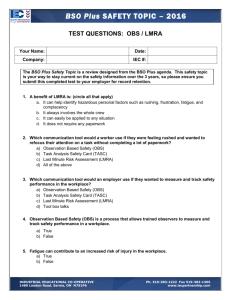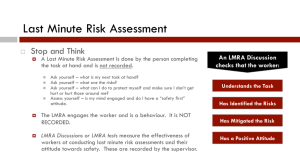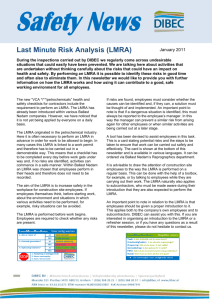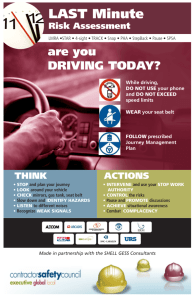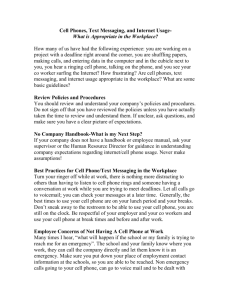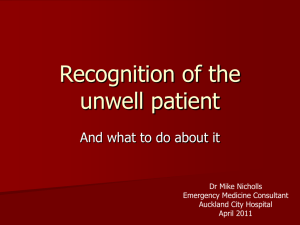Safety Topic
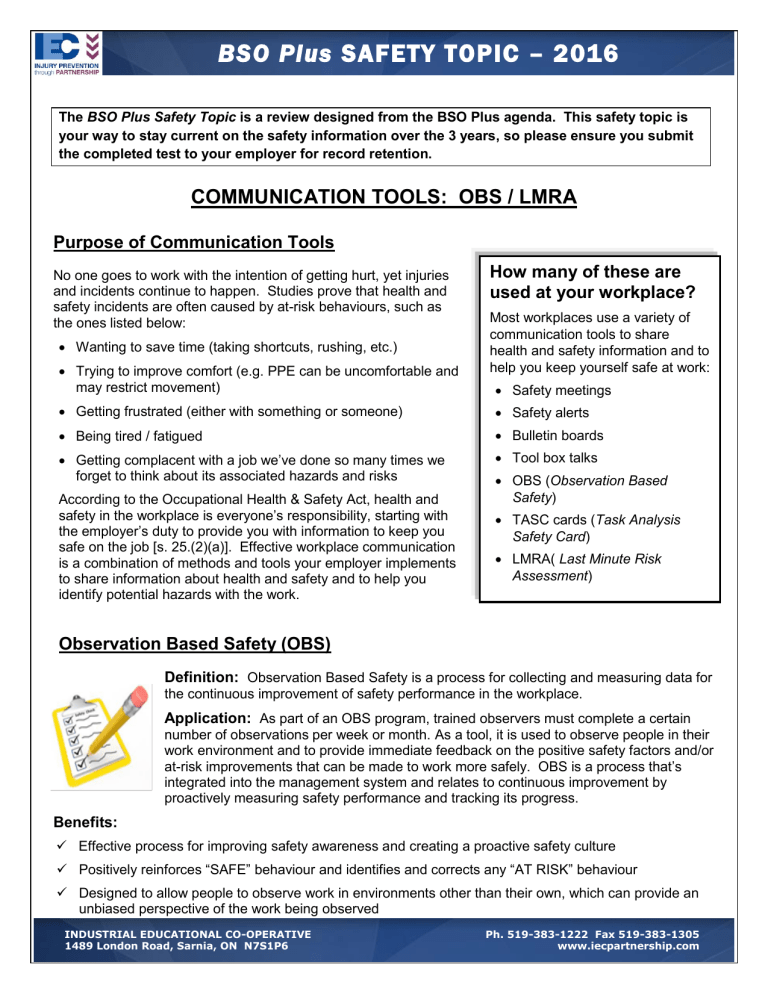
BSO Plus SAFETY TOPIC – 2016
The BSO Plus Safety Topic is a review designed from the BSO Plus agenda. This safety topic is your way to stay current on the safety information over the 3 years, so please ensure you submit the completed test to your employer for record retention.
COMMUNICATION TOOLS: OBS / LMRA
Purpose of Communication Tools
No one goes to work with the intention of getting hurt, yet injuries and incidents continue to happen. Studies prove that health and safety incidents are often caused by at-risk behaviours, such as the ones listed below:
Wanting to save time (taking shortcuts, rushing, etc.)
Trying to improve comfort (e.g. PPE can be uncomfortable and may restrict movement)
Getting frustrated (either with something or someone)
Being tired / fatigued
Getting co mplacent with a job we’ve done so many times we forget to think about its associated hazards and risks
According to the Occupational Health & Safety Act, health and safety in the workplace is everyone’s responsibility, starting with the employer’s duty to provide you with information to keep you safe on the job [s. 25.(2)(a)]. Effective workplace communication is a combination of methods and tools your employer implements to share information about health and safety and to help you identify potential hazards with the work.
Observation Based Safety (OBS)
How many of these are used at your workplace?
Most workplaces use a variety of communication tools to share health and safety information and to help you keep yourself safe at work:
Safety meetings
Safety alerts
Bulletin boards
Tool box talks
OBS ( Observation Based
Safety )
TASC cards ( Task Analysis
Safety Card )
LMRA( Last Minute Risk
Assessment )
Definition:
Observation Based Safety is a process for collecting and measuring data for the continuous improvement of safety performance in the workplace.
Application:
As part of an OBS program, trained observers must complete a certain number of observations per week or month.
As a tool, it is used to observe people in their work environment and to provide immediate feedback on the positive safety factors and/or at-risk improvements that can be made t o work more safely. OBS is a process that’s integrated into the management system and relates to continuous improvement by proactively measuring safety performance and tracking its progress.
Benefits:
Effective process for improving safety awareness and creating a proactive safety culture
Positively reinforces “SAFE” behaviour and identifies and corrects any “AT RISK” behaviour
Designed to allow people to observe work in environments other than their own, which can provide an unbiased perspective of the work being observed
INDUSTRIAL EDUCATIONAL CO-OPERATIVE
1489 London Road, Sarnia, ON N7S1P6
Ph. 519-383-1222 Fax 519-383-1305 www.iecpartnership.com
BSO Plus SAFETY TOPIC – 2016
Last Minute Risk Assessment (LMRA)
Definition:
A Last Minute Risk Assessment is a brief, mental hazard assessment of a task. An LMRA is often done on an individual basis but can also be done verbally with the work crew.
Application:
The LMRA is intended to focus a worker’s attention on the task. It is done by the worker before and during the work. It helps identify any unsafe behaviours and hazardous conditions that may have been missed in preparation for the work or which may have developed during the job. Workers must consider, what could happen if something goes wrong?
Benefits:
Proactive method for identifying the potentially hazardous personal factors of rushing, frustration, fatigue, and complacency
Quick and easy to apply to any situation
Your state of mind while you are working can affect how safely a job is being done. There are four common personal states of mind that may lead to critical errors, which, in turn, can lead to a greater risk or injury or death.
For example, while working as “safety watch”, you are more likely to enter the personal state of “fatigue”. This could lead to “eyes & mind not on task”, which could lead to an injury or even a fatality!
Stopping and thinking while you still have control is a form of a last minute mental check/risk assessment. It is important to continuously assess the situation, take one last look, and adapt to changes as necessary.
INDUSTRIAL EDUCATIONAL CO-OPERATIVE
1489 London Road, Sarnia, ON N7S1P6
Ph. 519-383-1222 Fax 519-383-1305 www.iecpartnership.com
